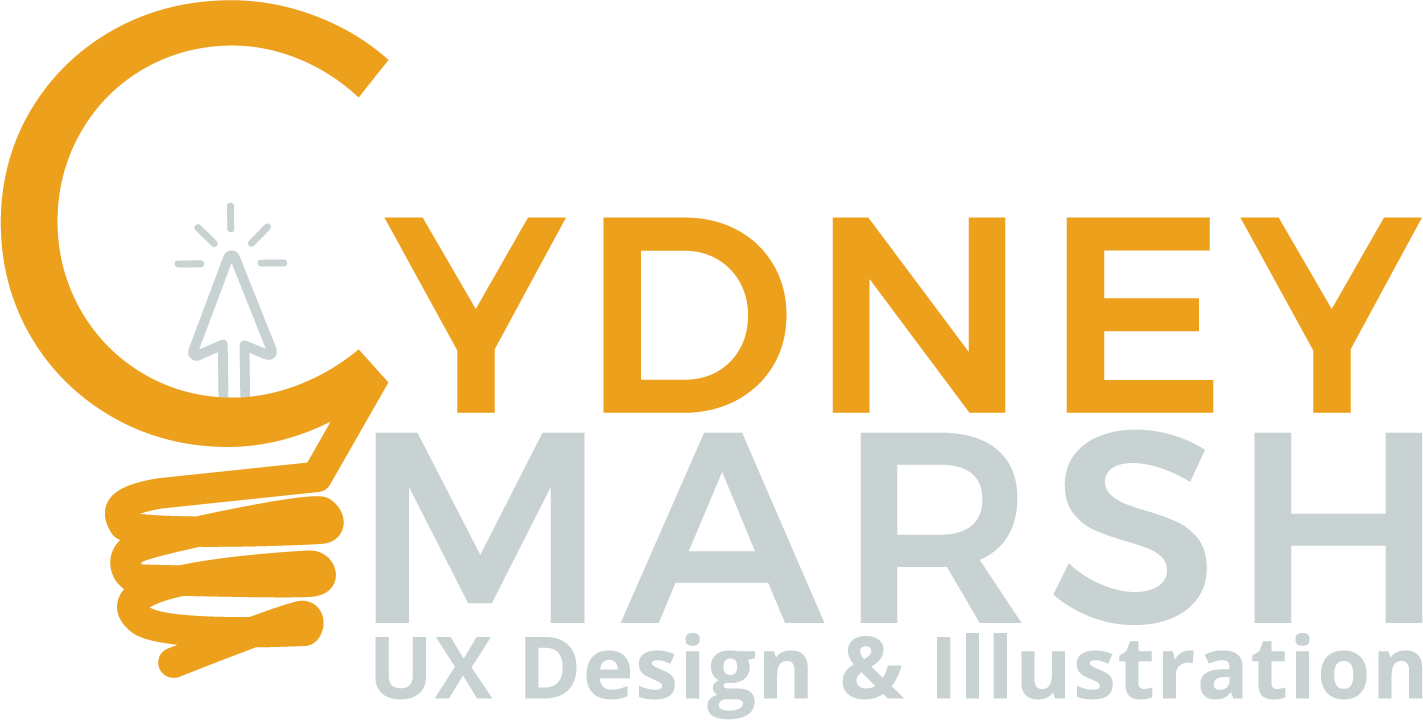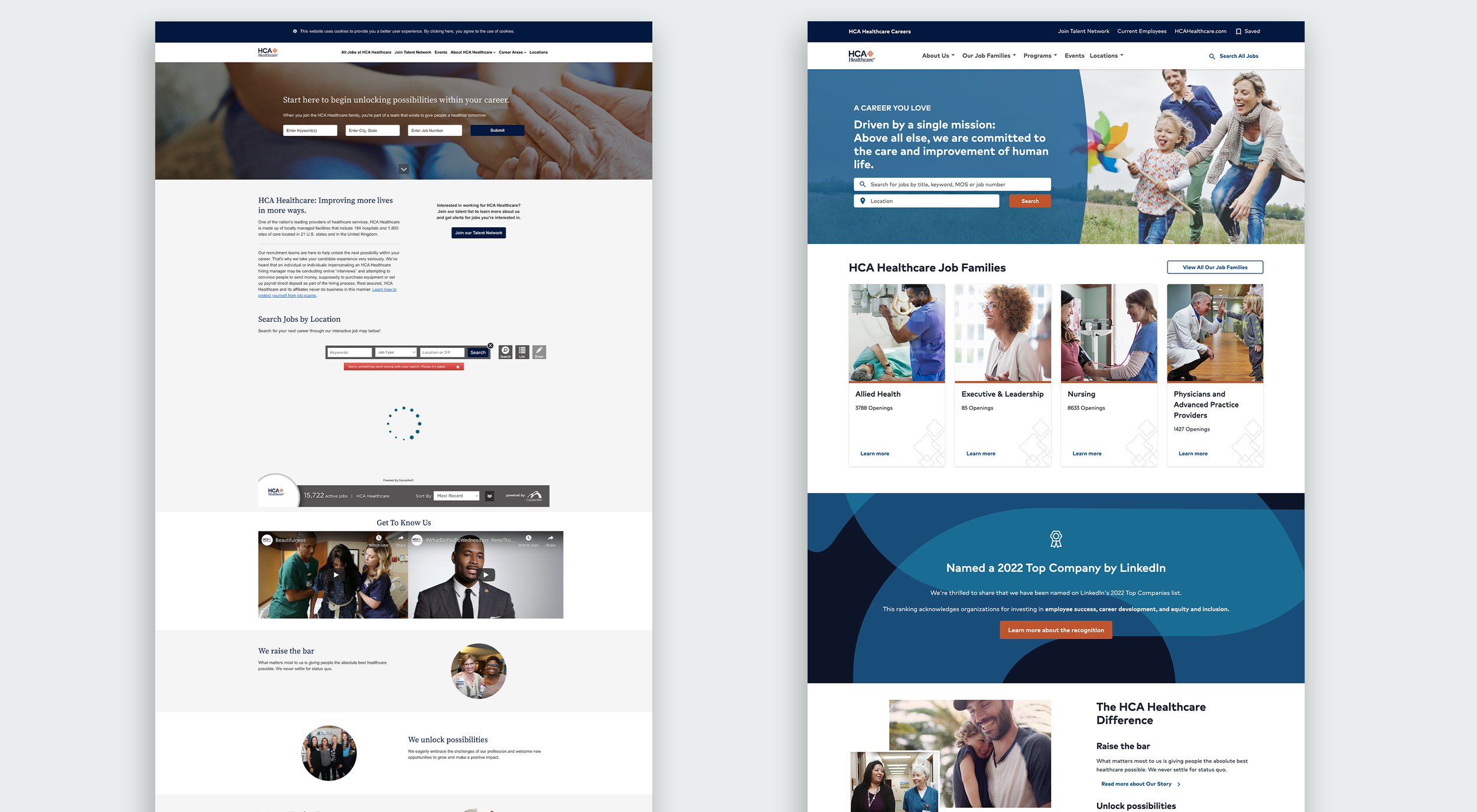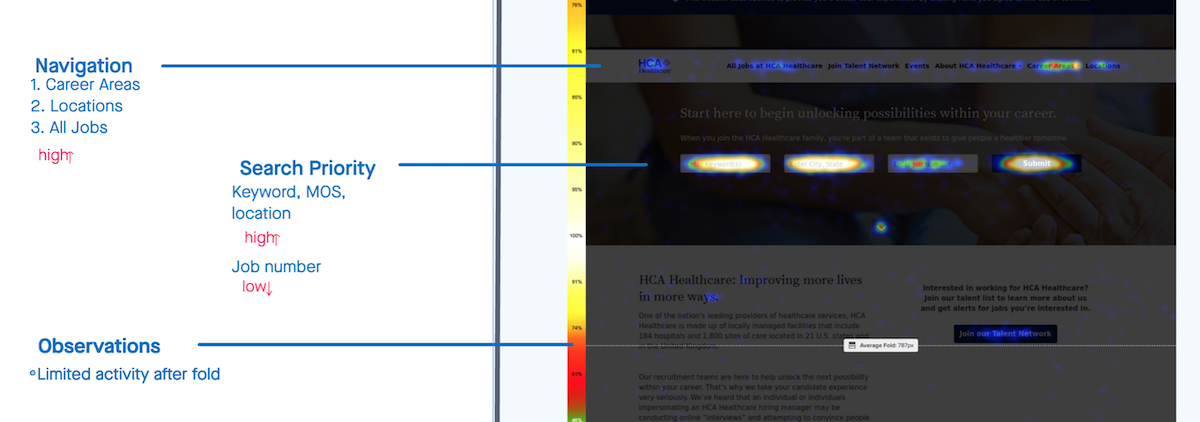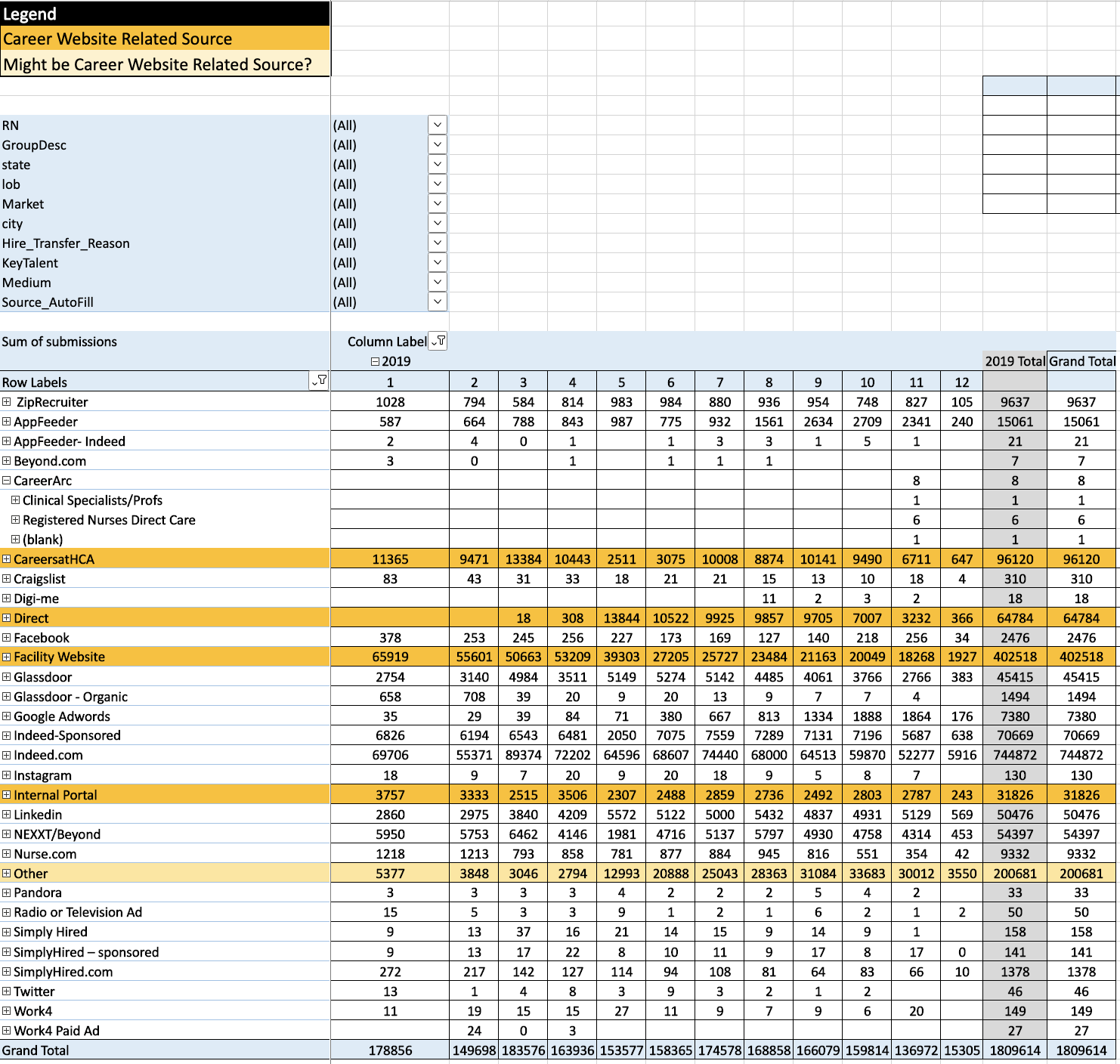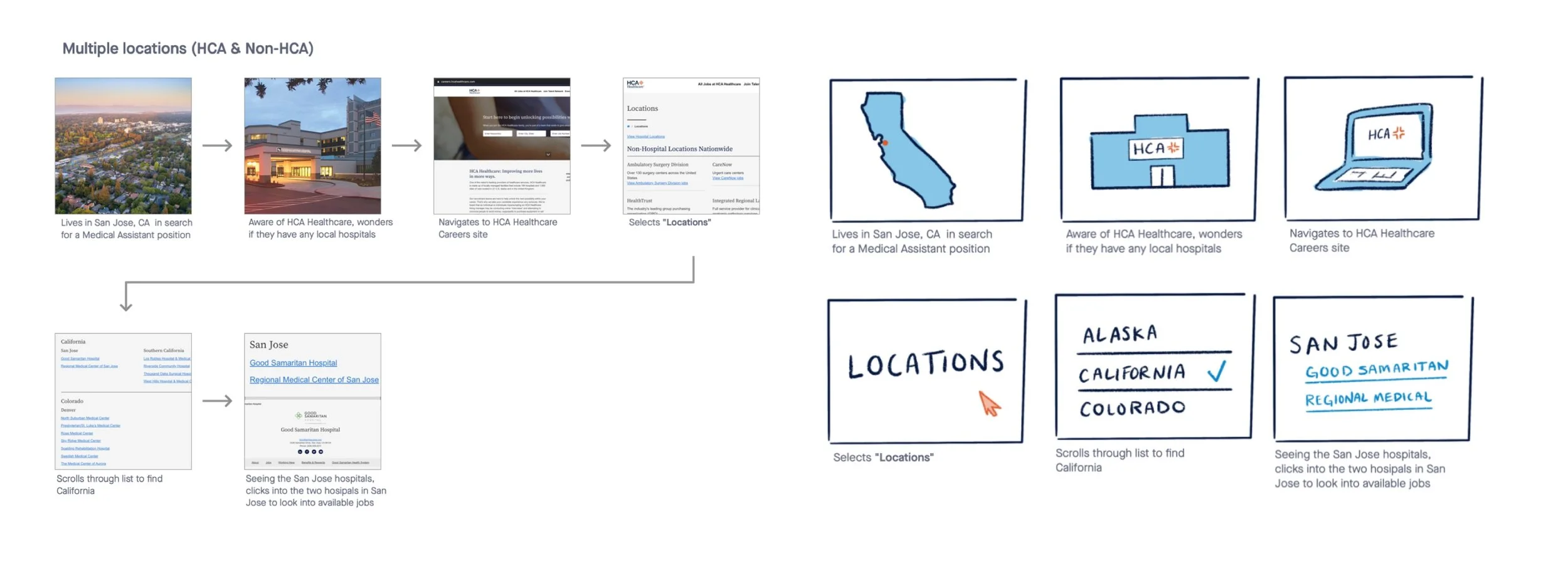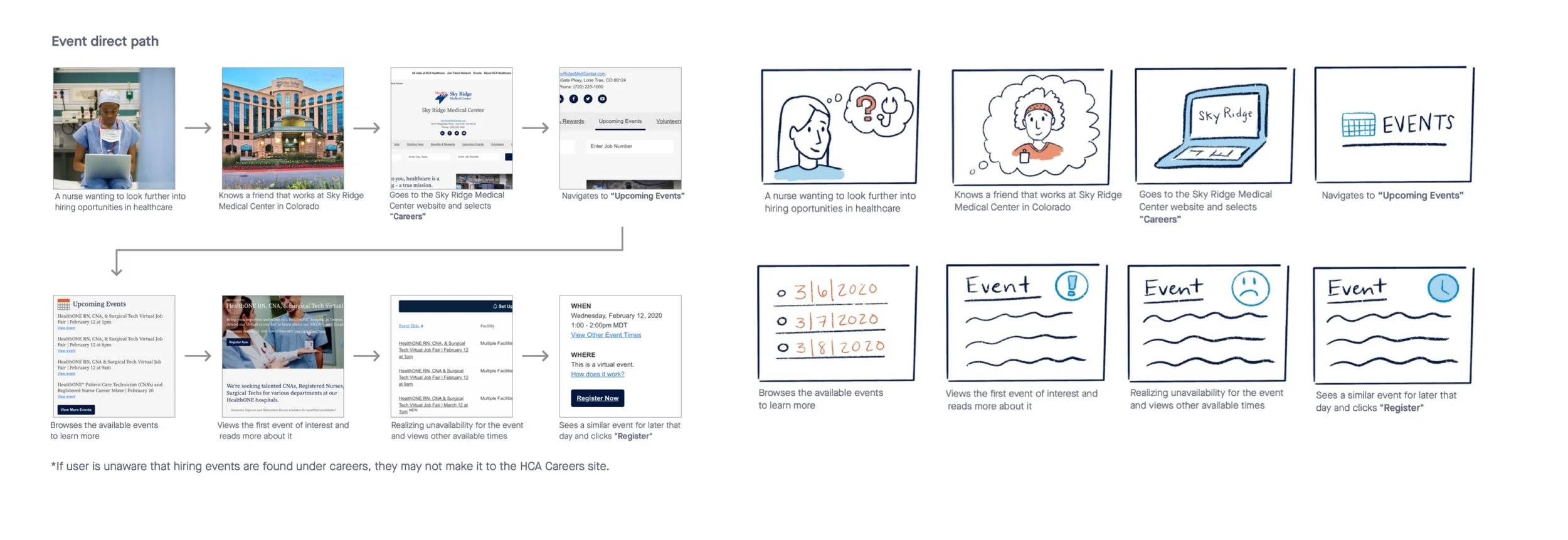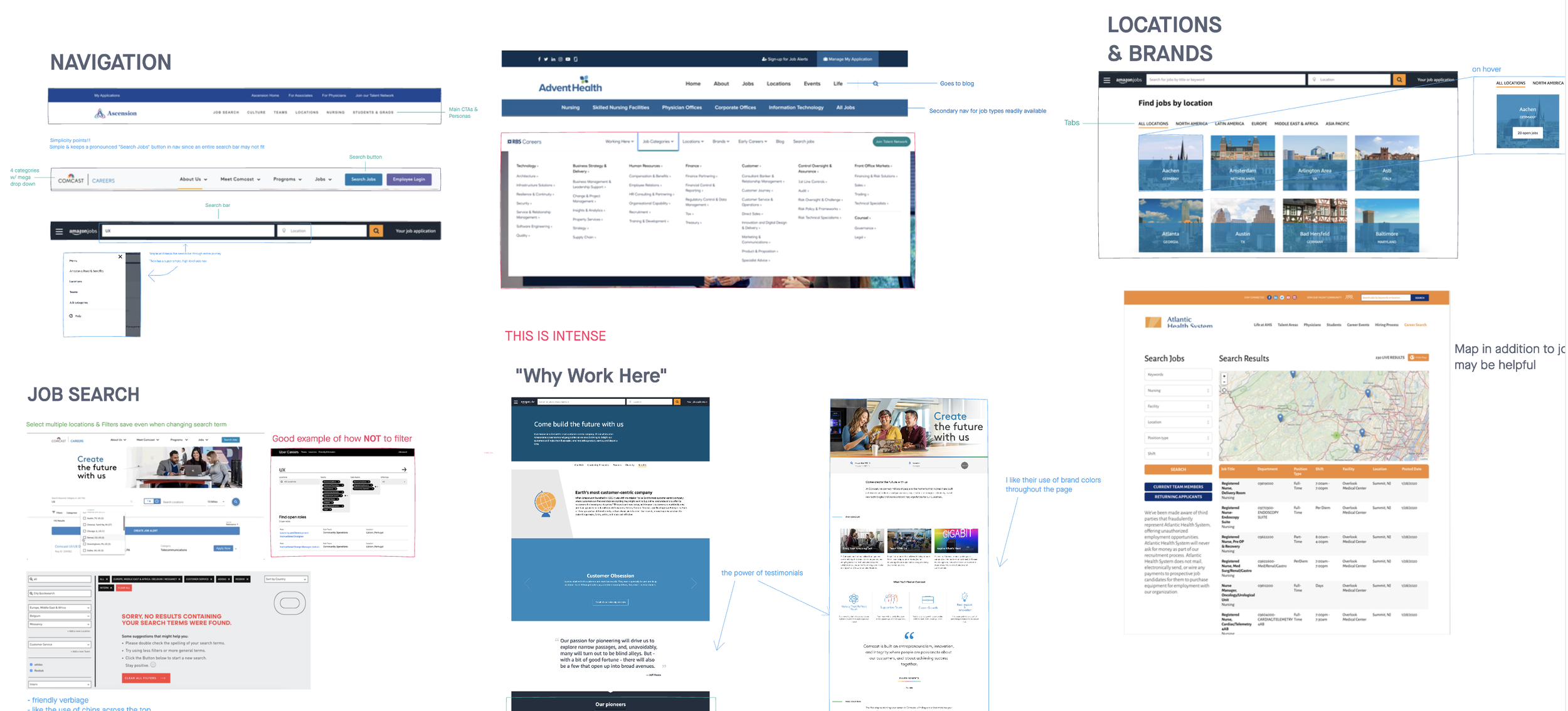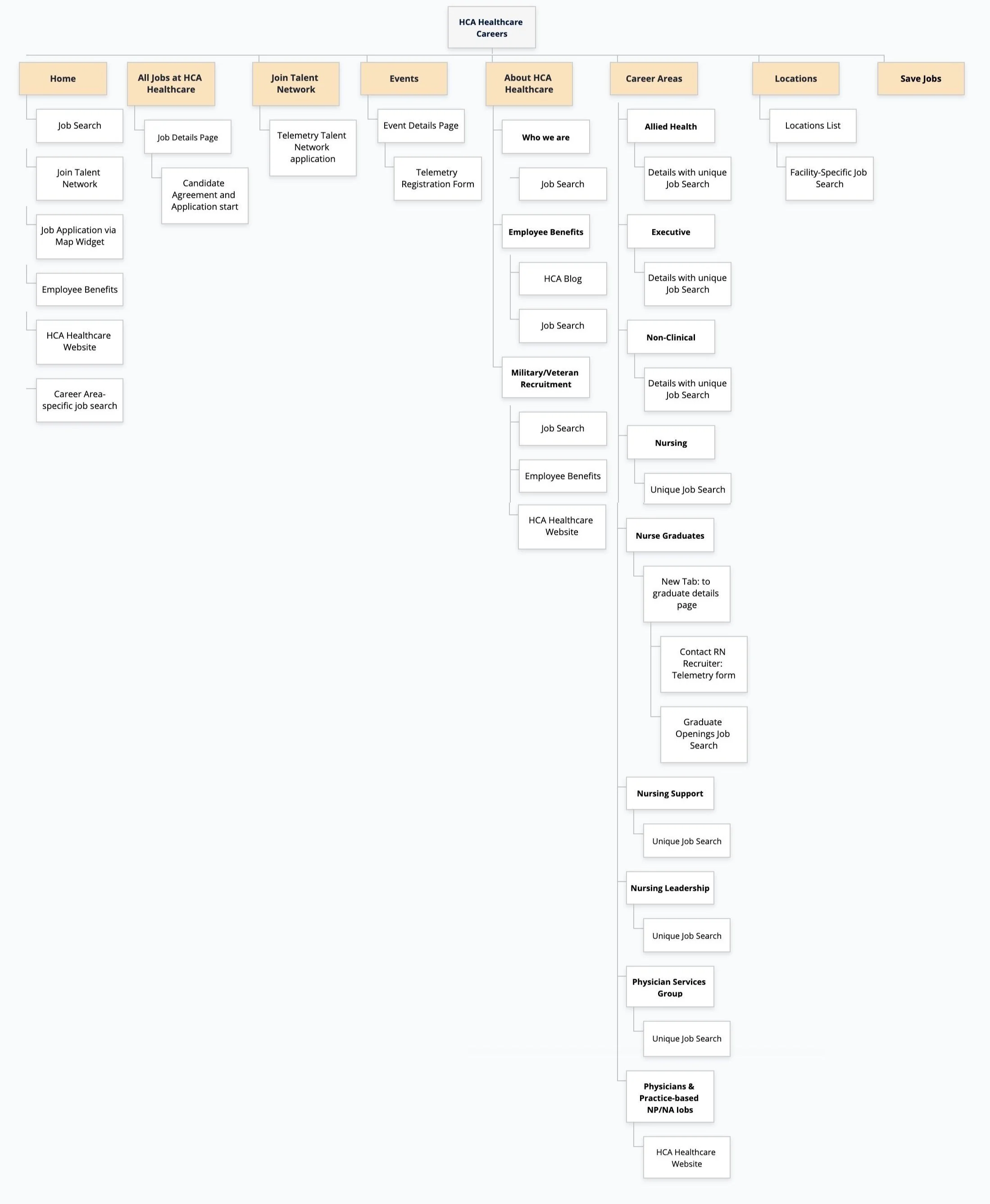UX Portfolio
✨Launched🚀
HCA Healthcare Careers
Overview
Revisited Iteration
1 mon. (2 sprints)
FEB 2021 – MAR 2021
Initial Redesign
7 mon. (COVID Choas)
JAN 2019 – JUL 2020
Critical ?’s We Were Determined to Answer:
What’s the everyday experience of scouting a career in healthcare?
What are visitors looking for in any new job? (Nurse, Dr, Tech, Janitor, Pastor, IT)
How do potential candidates feel when job hunting?
How intuitive is the site’s current state?
How can we improve that for the best recruitment analytics?
With nearly 800k visitors monthly and a high bounce rate, the HCA Healthcare global careers site wasn’t in for a quick makeover with our digital design system, Neutron. It needed a full overhaul. HR Recruitment Marketing contacted the UX Center of Excellence (UXCOE. That is my team, hola!) to revamp the experience from end to end.
🚨Spoiler Alert🚨
Our efforts improved the site and hiring analytics YOY quantitatively and the qualitative recruitment experience exponentially in a time of vast uncertainty.
Meet the Team
My Roles
Lead Moderated Stakeholder & User Interviews
Analyzed Site Data (Crazy Egg and Google Analytics)
Conducted Unmoderated Usability Tests (Task-Based, Snap Study, A/B, etc.)
Performed a Competitor Market Analysis and Pattern Analysis
Created Personas, Journey Maps, and Storyboarding
Lead Tree Testing and UX Writing of Sitemapping
Lead Wireframing
Teamed up on UI Design and Prototyping
Quality Assurance Checked Hi-Fidelity Interaction Design
HCA Careers Case Study Phases
Empathize & Define
Stakeholder Surveys and Interviews
At the start of the new year, I and a new UX Designer I was training at the time, Cora Rusk, hit the ground running in discovery. I designed the interview script we used with HCA Healthcare’s Recruiting, HR marketing, and the job platform Talemetry stakeholders. These interviews helped us determine critical user personas to find, high-level objectives, existing site successes to accentuate, areas of opportunity to improve, ease of use metrics to benchmark, competitors to observe, and the stakeholder’s qualitative site ratings.
Key performance Objectives from Stakeholders:
✅ Employee Value Proposition (EVP) needs to be clear and emphasized throughout
✅ The site should build trust and confidence with the potential candidate
✅ Engage the candidates with interaction design, a trim experience, and streamlined architecture
✅ An intuitive conversion-focused site that helps people feel encouraged by the culture to apply
✅ 0 to 1-click job search with filter options accommodating both the candidate and the recruiter
✅ High-impact content that is inspiring, informative, expressive, entertaining, actionable
✅ Diversity and inclusion initiatives need a showcase on the site.
✅ Customizations to tailor small markets while balancing consistency within an enormous legacy corporation.
Current Usability Avg. Rating 3.1
Excessive search glitches
Long page loads
The “Talent Network” link was ambiguous
Legibility of lengthy pages needed improvement
Provide more areas for Infographics and local market content
Current Site Structure Avg. Rating 3.1
Lengthy top navigation link verbiage
Terms and lingo that did not match candidate vernacular
Severe lack of landing page CTAs
Inability to search for multiple cities/locations or remote at once
The journey of reaching a job posting toppled over 4 clicks at best.
HR & Culture Content Avg. 2.8
More visuals and videos could be present
Career programs are too underrated and buried within the site
Build candidate trust with testimonials.
Due to an increase in job scams, social proof would be necessary
Genuine imagery featuring warm and candid faces
Visual design Avg. Rating 2.6
Outdated appeal
“cold hand” zero personification images too prevalent.
Stakeholders desired Lifestyle candid imagery
Extremely verbose pages, inaccessible cognitive overload
Adding HCA’s branding in a way that still balanced individual market brands
Analytics
CrazyEgg’s optimization heatmaps allowed us to view the most frequently visited areas of the site in the last 60 days. As the site’s primary action the hottest on the landing page was the search icon. However, everything else below the main search was ice-cold. Not lukewarm; straight icicles. The candidate’s lack of exploration of our benefits and culture was an extreme concern. The format below the main site search wasn’t engaging or exploratory as possible. While the content was present, it was in a blind spot front and center with nothing in particular screaming for attention.
HCA Careers Landing page Dec 2019 - Jan 2020
When comparing how active the main search fields and filters were to the rest of HR Recruitment’s valuable content pages, the difference was still vast. We hypothesized why these items might be missed after cross-referencing the Application and Hire Source Report from the site’s development platform Talemetry. It appeared as if recruits could be experiencing fatigue if they entered from a third-party job site. Suppose users previously encountered a streamlined, consistent, and robust search experience on LinkedIn, ZipRecruiter, and Glassdoor. In that case, according to Jakob’s law, they may be less inclined to explore our different HCA Careers site designs.
Job Search Heat Map - Search functions received the most action. Not the results, or navigation.
Application & Hire Source Report for 2019 - high usage from third parties
Job searching often takes weeks, if not months, for a candidate. Our takeaway was to remove any functional design variability of our site during that tiring term to not contribute to their fatigue. However, we would only be consistent in the job search functionality. We would utilize the Von Restorff Effect design variability to highlight our brand and content to make it stand out in a sea of other companies. We also determined we needed to focus on the global enterprise content pages, search, and division location pages for this immediate project’s scope. Due to their large number and variety, the individual job description pages ended up temporarily in the backlog of this scope. Job Description pages got their own focused overhaul later in the Iteration Phase of this project.
User Interviews & Surveys
We chose to interview two types of “power users” identified by stakeholders for the remainder of January. The first group of users was 5 HCA employees who were recently hired in the last 30 days. We asked them about their recent experience applying and any other sites they used in their job search before settling on HCA. We also asked task-based first impression questions to benchmark the site’s current state. We needed to learn why these recently hired employees ultimately chose our corporation over others. What made us stand out in the sea of other hospitals or companies?
The second group was 6 HCA Recruiters for particular departments. We asked them about their experienced tailoring market brands within the large legacy corporation. We wanted to know what tactics worked best for them in getting candidates to feel the warmth of their small community while still bridging the support of the enterprise. This second group also interacted with the candidates the most. We asked the recruiters what they had heard about the candidate’s user experience from their close perspective.
Aside from moderating and drafting the user interview script, I also crafted an anonymous 10-question survey on Survey Monkey that was emailed to recent applicants on the site. These 2 types of user interviews and the qualitative survey helped us gather our personas’ likes, dislikes, needs, and competitors. This info also came in handy for the later competitor pattern analysis.
There were a few questions to help us empathize with any points the users were currently encountering. We utilized this information for journey maps and storyboards. We highlighted friction points and user-identified points of importance within the surveys and the user interviews.
Personas
Before configuring the new architecture and laying the groundwork for design ideation, we identified 7 types of personas in various verticals:
Seasoned Nurses in multiple units
Students Entering Workforce (both healthcare or office interns)
Allied Health Support (Pharmacy, Techs, etc.)
Ancillary Support (Environmental Services, Mechanics, etc.)
Recruiters in multiple communities (not pictured right)
Corporate and IT job seekers
Enterprise Leadership
Due to the unique nature of securing residencies of doctors, practicians, and physicians, these personas were not heavily regarded in this effort. However, HR Marketing is currently working on the distinctive user experiences of doctors and their “Practice with Us” landing page on the HCA Careers site in 2022.
Journey Maps
Journey maps walk alongside a key persona as they go through the motions to complete a task. We started our Journey Maps by focusing first on the Experience map of our primary persona, the New Student Nurse, before repeating the same process for the other personas.
The experience map pictured right showcases Maria’s job search journey in and outside of her first encounter with HCA’s Branding and services. We wanted to capture the beginning emotional rollercoaster of job searching well before she would be interviewing or deciding on a job offer.
While we identified the highlighted steps a user may take in a wide-sweeping experience map, I also detailed the emotions, thoughts, and observations in empathy maps for each of the phases in the experience (below). This helped capture the current qualitative state of the site, where unsatisfactory moments occur, and why.
Ideation & Early Prototyping
Storyboarding
Journey Maps were then married to a Current State Story Board. This Current State Story Board helped us identify the areas of poor engagement, information, and the unfortunate amount of clicks it took to complete a task. We started using screenshots of the current UI to showcase what the user was interacting with during each step along the journey. Instantly, we identified the number of clicks, actions, points of confusion, and overall flow.
I then partnered with UX Designer, Kristin Fowler, to create an Illustrated Storyboard to capture the high-level process users were encountering in the same interaction points. Seeing a summary illustrated allowed us to unite as a team and not get “too in the weeds.” We could easily see points of interaction that could be streamlined as low-hanging fruit. The hand-drawn current state helped stakeholders capture the big picture pitfalls of the site as it existed current in multiple critical tasks.
Using the hand-drawn illustrations, we constructed the ideal journeys of different tasks. To bookend discovery and fade into ideation, the Ideal State Story Boards helped support our heuristic suggestions and changes in site mapping later.
Current State Story Boards 2020
Competitor Analysis
To establish site architecture and get design inspiration, we looked to the current market of careers sites—both direct healthcare and indirect competitors.
Healthcare adjacent industries (Urgent Cares, Hospice, Wellness Companies)
Warm Hospitable Tone Multi-branch corporations (Hotels and Home brands)
Well known Tech Companies
An immediate focus on companies who built their careers sites on Telemetry
We scoured 24 direct and indirect competitors such as AdventHealth, Ascension, Tenet Health, United Health, JC Penny, RBS, Comcast, Amazon, etc.
This study uncovered how other companies handled the functional design of general tasks and critical objectives. We feverishly examined job search orientations, approaches to displaying multiple locations or brands within a single corporation, landing page strategies, and site tone. We also considered common copywriting language, image styles, and video topics.
Key Market Analysis Takeaways
Search: do not hide the search behind a navigation tab; keep it front and center by promoting search opportunities throughout the entire site journey.
Filtering: above-content in the common region of searching frees up the horizontal real estate for job listings. It also utilizes the Gestalt Law of Proximity in its dynamic updates below and Hick’s Law to break up more expansive filters until the user is ready.
Personalization: Showcasing a job search “by your interests” and having the ability to save jobs without logging in enhanced the experience with Goal Gradient Effect. Also, including features like an intelligent chatbot made the job hunt more intimate.
Culture & EVP display: sites we recognized as having greater strength in these areas included testimonials, authentic videos, and candid warm imagery. They also had an engaging employee benefits page and presented reviews to provide trust in social proof.
S.W.D.UX.O Method- Strengths, Weaknesses, Visual Design, UX journey notes, Opportunities.
Sitemap Proposal
Now equipt with through research and early ideas flowing, UX Designer Rachel Wagg and I took a moment to make a first draft of the new site architecture. We used GlooMaps to develop our proposed map. At a very high level, determined what the primary paths of the site were and the routes they created to one another. We altered the main navigation's UX writing to match user linguistics and swapped the lengthy labels for shorter, more straightforward verbiage. Additionally, we condensed content by organizing pages that were similar into groups. Our partners came into GlooMaps to make notes, link to other pages stakeholders were aware of outside of the site, and modify the map, offering a wonderfully collaborative experience. After a successful tree test with users, we proposed a slightly iterated finished sitemap (displayed to the right, below).
Lengthy and Verbose Sitemap Before Edits
Simplified NEW and Improved Sitemap
Design Session Early Wireframing
We asked our stakeholders, business partners, and recruiting power users from all over the country to come and collaborate on early ideation in an in-house design session. All hands were on deck, making 8 teams of 4 that wireframed a page in phases over breakfast. We handed folks a sticky note pad and 3 sheets of printer paper labeled Events Page, Location Page, and Interests page. They slapped sticky notes down to brainstorm a list of the content and features they thought each page should contain as a team.
Groups decided which of the pages they would like to sketch out. Then participants were asked to pop open a marker and independently scribble out a wireframe for 15 minutes on their own 11x17" paper. When the time was up, participants shared their wireframes in a quick speel amongst their group. This short round-robin show and tell within squads allowed participants to vote on their favorite parts of their teammates' wireframes and collaborate on new ideas.
Finally, the teams were tasked to wireframe again, uniting concept sketches into one larger 20x23" Wall Sticky-note pad. When the music ended, a nominated presenter from each squad shared the group's wireframe with the room. After presentations, All participants received only 5 circle stickers in total. They could use these stickers to vote for their favorite components on any group wireframes, thus creating a heatmap. We collected the dotted-up group wireframes take with us to formal wireframing.
Testing & Finalizing Wireframes
Using InVision Freehand as our flavor of choice, Rachel, Cora, Ryan, and I wireframed formal digital sketches of the entire site. We made a blank frame for each section on our proposed site map. Then we began filing through our takeaways from competitive analysis, stakeholder interviews, user interviews, and the lists and wires from the design session. The initial design of the careers site was starting to reveal itself.
Once we had the screens wireframed, we stitched the skeleton designs with InVision's hot-spotting feature. This method allowed the early blueprint designs to respond just as if they were a fully developed site. This interaction step in InVision helped us gather candid user feedback via UserTesting.com early rather than further down the road in full-color prototyping.
We first presented the user with a cold open screen and asked users what their usual process was like when looking for a job, and what they would expect from a hospital corporation’s career site before revealing the wires. Once the wires were revealed we asked how well the site structure met their expectations, what they liked, disliked, want to be reorganized, changed, labeled differently, and what was missing. We planned content with mostly grey for placement only photo ratios and 80% lorem ipsum placeholder text. We also shared this early wire prototype with our front-end developer at Talemetry, Doyle See. He gave us a direction of features and functionality that may not be achievable in the Talemetry environment and other notes to be cautious of when going into the hi-fi.
